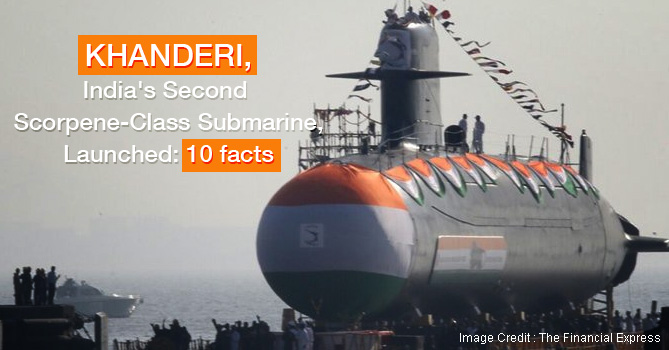Indian Navy saw the addition of a new submarine to its fleet of 15 submarines, with the launch of Khanderi, India’s second French-designed Scorpene-class diesel-electric attack submarine. The launch took place at Mumbai’s Mazagon Dock Shipbuilders Limited today, January 12, 2017.
The Indian Navy operates 13 conventionally powered submarines and two nuclear submarines and the launch of Khanderi under the Scorpene project comes as a welcome news, as it is critical for the Navy’s growth. Named after an Island fort of the Maratha forces which played a vital role in ensuring their supremacy at sea in the late 17th century, the Khanderi promises to be a very valuable addition to the Indian Navy fleet of submarines.
At present, six submarines are being built in collaboration with France’s Direction des Constructions Navales (DCN) in a three-million dollar project at the Mazagon Docks, under a transfer-of-technology agreement with the French.
All these submarines belong to the Kalvari Class based on the Scorpène-class submarine and are attack submarines.
India’s first Scorpene-class submarine, Kalvari is also due to be commissioned shortly once the sea trials are completed. The other four submarines are expected to be launched at nine-month intervals after the Khanderi.
The launch of Khanderi took place in the presence of Union Minister of State for Defence Subhash Bhamre and Chief of the Naval Staff Admiral Sunil Lanba.
Features of Khanderi
- The Khanderi is armed with torpedoes as well as tube-launched anti-ship missiles.
- The missiles can be launched from both underwater and from the surface.
- With superior stealth features, rendering it the attribute of invulnerability that is unmatched by many similar submarines, the Khanderi can launch a crippling attack on the enemy using precision-guided weapons.
- The Khanderi can also run in extreme temperatures and thus can operate even in the tropics.
- It can be used for anti-surface warfare, anti-submarine warfare, intelligence gathering, mine laying and area surveillance.
- The submarine is powered by a diesel-electric engine. That means that Khandari won’t be able to remain submerged for long durations and will have to resurface to recharge its batteries using a snorkelling pipe.
The Process of Construction
India holds the esteemed position of being in the exclusive group of the few countries that produce conventional submarines. It joined this elite group in 1992 when the first Indian-built submarine INS Shalki was commissioned. Two years later, the INS Shankul was commissioned. Both are still in service. The process of building the Khanderi was as follows:
- The Khanderi has been built using the “modular construction” technique.
- The entire process included manufacturing the different sections separately which were then outfitted concurrently.
- The assembling of the submarine was a complex procedure.
- It involved putting together different sections and laying of several kilometres of cabling and piping in extremely congested compartments.
- Diesel submarines face the issue of a vacuum in the submarine when the head valve is submerged. The most important safety milestone of “vacuum testing” for Khanderi was completed in the very first attempt on January 5.
- Khanderi will now undergo rigorous sea trials as well as trials at the harbour till December, 2017.
- Once the trials are completed successfully, the Khanderi will be commissioned in the Indian Navy as INS Khanderi.
A few Setbacks
- The primary weapon of the Scorpene submarines is the Black Shark torpedo. However, the firm manufacturing these torpedoes is linked to the Italian firm Finmeccanica, which has been blacklisted after the Agusta Westland VVIP chopper scam. The Navy is looking to procure alternate torpedoes.
- The Scorpene project has also been in the news lately after details emerged of leaked technical data, but the Indian Navy believes the leak of information – published by an Australian daily – does not compromise the operational prowess of the submarines.
It goes without saying that India holds a vital geo-strategic position in the Indian Ocean. Regional peace and stability is crucial as it will contribute towards the growing international stature of India and its burgeoning development. Addition of Khanderi to the fleet of Indian Navy, as well as the other five submarines under construction, will further ensure Maritime security so that India continues with economic development undeterred.






